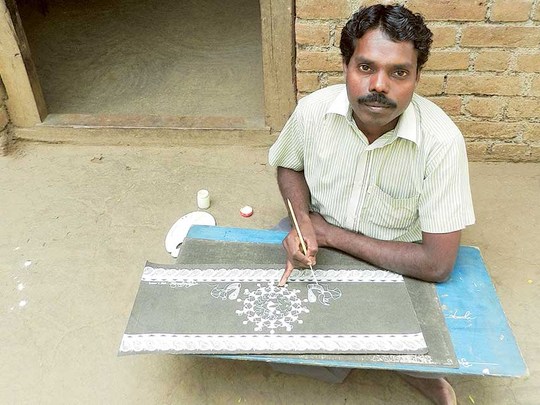
Simple geometric forms dominate the artistic vocabulary of 32-year-old Sandip Madhav Bhoir. Sitting cross-legged, Bhoir bends over a square canvas laid flat on the dung-smeared floor of his home in western India, immersing himself in a universe of people, animals, trees and hills that seem to come alive with every stroke of the brush. With his simple, linear forms devoid of fine detailing but pulsating with energy, Bhoir communicates a way of life that he was born into, a world where nature is worshipped and held supreme, where utmost faith is placed in the divine balance between humans and the natural world.
Brought up in the picturesque environs of Veti, a rural district in Thane, 120 kilometres off the northern outskirts of bustling Mumbai, Bhoir is a member of the indigenous Warli tribe, a community of forest dwellers who have, over the centuries, made a gradual transition towards becoming a pastoral community.
“We revere this land that we call home,” says Bhoir, sitting on the verandah of his mud-walled single-room house. “Since ancient times, our forefathers have lived in meaningful coexistence with the natural world. The birds, animals, trees, even the sun, moon and the stars are looked upon with great reverence. The name of our tribe is derived from the word ‘warla’, which means piece of land and we have learnt to mould our lives to the rhythm of nature.”
It is this appreciation of the natural world that manifests in the richly textured pictorial language slowly unfolding on the handmade paper. “The circles you see here represent the sun and the moon,” he explains. “Triangles depict mountains and trees, and when two triangles are joined at their corners, you get the human form. Squares represent a piece of land or a sacred enclosure where we worship Palghat, the deity of marriage and fertility.”
The present set of paintings does not depict mythological characters or images of deities; rather, it is a vivid expression of the daily life and social events of the Warli tribe created in a rhythmic pattern. Historical records trace the roots of this art to as early as the 10th century AD.
“The Warli paintings were originally used to embellish the walls of village houses,” he says, as he proudly displays a painting depicting the “tarpa” dance on the austere mud wall inside his home. (The tarpa is a wind instrument made with bamboo and gourd and played for the dance usually performed by both men and women during the harvest season.)
The painting on the wall was done by his wife, he says, and was made with a mixture of rice flour and water with gum as a binding agent. “On every festive occasion — be it the celebration of a birth, marriage or harvest — traditionally, it is the woman of the house who decorates the wall with scenes from everyday life. A bamboo stick, chewed at the end to make its fibre work like a paintbrush, is used for the painting. The contrast of the red mud walls against the stark whiteness of the rice paste gives Warli paintings incredible life and depth. It may surprise you to know that men took to Warli painting less than a few decades ago when the art form was first made known to the world.”
It was sometime during the early 1970s that Pupul Jayakar, India’s cultural doyenne who revived many traditional art forms across the nation, stumbled upon the mural art form practiced by the Warli tribes of Maharashtra. Fascinated by depictions of the tribal deity that adorned the interiors of every household, she encouraged them to experiment on nontraditional materials, such as paper and canvas, and to explore their myths, folk tales and daily rituals in their paintings.
The rudimentary graphical depictions of everyday life — lush forests, jungle trails, heavy monsoon rains, dancing peacocks and human forms in animated movement — of the tribal people living near the Mahalakshmi Hill soon caught the attention of the national and international connoisseurs of art. Warli art became known for portraying the vibrancy of an ancient culture and the artists moved away from depicting deities to creating scenes rooted in their folklore. Believing that everything is interconnected, concentric patterns illustrating the circle of life are a common theme in Warli paintings.
“This was the beginning of the commercialisation of the art form,” notes Bhoir, “and in the process it also drew the menfolk into it. They soon took to painting as a supplementary source of income.”
With absolutely no training or formal initiation into the art form, Bhoir remembers being drawn to it after watching the women members of his family participate in this ritualistic art during festive occasions. “I started practising at the age of 14 with pencil and paper. As my confidence grew, I began to experiment with acrylic, now commonly used by all artists.”
His main occupation, however, is farming, he says. He points to a grain container made of reed and plastered with dried teak leaves that act as insect repellant. “The harvest of rice and pulses from my small patch of land is stored here, but that alone is not enough to meet the needs of my growing family.”
Bhoir took to selling his paintings to make ends meet. His inexperience in and poor knowledge of marketing and dealing with clients came in the way and he was forced to rely on the services of middlemen who resold his work at much greater value to urban and international buyers.
The pittance thus earned has forced many artists of his village to give up painting and work as labourers.
It wasn’t until Ayush, a non-profit organisation founded by a group of young educated members of the tribe came into being that artists such as Bhoir finally began to realise the true worth of their art form.
Ayush was set up not merely to cater to the needs of the Warli artists, explains Sachin Satvi, a founding member. “Warli paintings are just one aspect of our culture. Since ancient times, the tribal people have developed a unique way of life that is largely self-sufficient and diverse. Yet, simply because our communal ways are different, we are portrayed as primitive and backward. Our chief aim therefore is to raise awareness of our centuries-old history; preserve and promote traditional knowledge of our tribal communities, which includes cultural values, art, handicrafts, music, medicine, language and lifestyle.”
The desire to set up Ayush also rose from the fact that while tribal students learn about many art forms across the globe, the cultural history of their own ancient art finds no mention in school textbooks. “It is the agents or middlemen who profit from the art while the artists struggle to put two square meals on the table. Many of them have taken up labour work. If action is not taken, the art will slowly die. Tribal people are the custodians of a rich tradition of folk arts in the Warli community. It is our duty to help preserve this heritage.”
By giving members of the Warli tribe a platform to address issues and voice their concerns, the threat to their lands and resources being taken away in the name of “progress” has reduced. Last year, Ayush also helped secure the Geographical Indications (GI) status for Warli paintings, thereby ensuring that the intellectual property rights of the Warli artists would be protected.
Bhoir admits that ever since Ayush intervened, there has been a significant improvement in the living conditions of artists such as him. “We are now paid the real worth of our work as we sell directly through Ayush at exhibitions, through an online portal and other events. After years of struggle, we are finally experiencing the rich rewards that come with pursuing a passion that is intrinsic to our very existence.”
As he proceeds to dip his brush in the pot of white paint, Bhoir says all he hopes for is that the new generation of the Warli community will keep its traditions alive while balancing its role in the modern world.
Sangeetha Swaroop is a writer based in Dubai.











